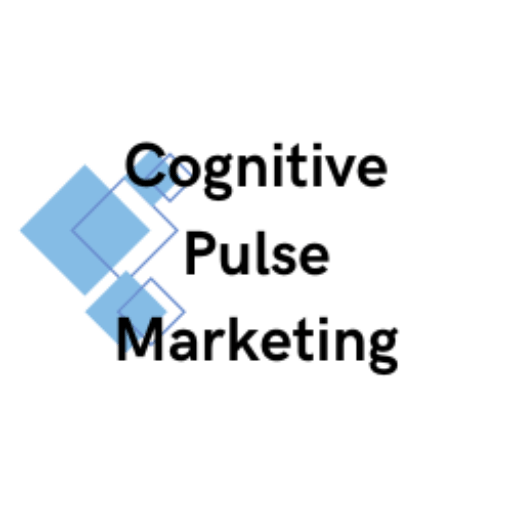If you’re a therapist, private practice owner, or mental health professional, you already know that getting new clients isn’t as simple as opening your doors and waiting for people to walk in. In today’s digital world, word-of-mouth referrals aren’t enough—your online presence plays a major role in whether potential clients choose you or someone else.
But here’s the challenge: marketing a therapy practice isn’t like marketing an e-commerce store or a restaurant. Your approach needs to balance visibility, trust, and compliance, all while keeping your focus on what matters most—helping clients.
That’s where digital marketing comes in. Done right, it can:
- Bring in consistent, high-quality leads instead of waiting for referrals.
- Position you as an authority in your field so that potential clients trust you before they even reach out.
- Ensure your practice is easy to find online, whether through Google searches, paid ads, or your website.
But with so many marketing strategies out there, where should you focus?
The Three Core Pillars of Digital Marketing for Therapists
While social media has its place, our strategy focuses on the highest-impact channels that drive client inquiries and long-term growth. These include:
- [SEO for Therapists] – Helping you rank on Google so that when potential clients search for therapy services, your practice appears first.
- [Google Ads for Therapists] – A shortcut to visibility, ensuring you get in front of the right clients immediately without waiting for SEO to build momentum.
- [Websites for Therapists] – Your most important online asset—where first impressions are made, inquiries happen, and potential clients decide to book.
What You’ll Learn in This Guide
This guide is your step-by-step roadmap to creating a marketing strategy that attracts, nurtures, and converts potential clients into booked sessions.
Here’s what we’ll cover:
- [SEO for Therapists] – How to rank higher on Google, optimize your website, and attract organic traffic that turns into paying clients.
- [Google Ads for Therapists] – How to run targeted ad campaigns that bring in high-quality leads without wasting your budget.
- [Websites for Therapists] – What your site needs to convert visitors into appointments, plus best practices for design, speed, and user experience.
By the end of this guide, you’ll have a clear, actionable strategy for growing your therapy practice online—without the guesswork.
🔹 Ready to get started? Let’s dive into SEO, the foundation of every great digital marketing strategy.
Tips
Text Filler for tips, tricks, Lead Magnets and More
Text Filler for tips, tricks, Lead Magnets and More
Text Filler for tips, tricks, Lead Magnets and More
SEO for Therapists: How to Rank Higher and Attract More Clients
A potential client is sitting at home, feeling overwhelmed, knowing they need help but unsure where to turn. They pick up their phone and type, “therapist near me” into Google.
At that moment, their choice isn’t based on a personal referral or a recommendation from a friend. Their decision is shaped by who shows up first.
If your practice isn’t appearing at the top of Google search results, you’re invisible to clients who are actively searching for therapy right now. That’s the power of SEO (Search Engine Optimization).
Unlike paid ads, SEO doesn’t generate instant results. It’s a long-term investment—but one that pays off month after month as your site climbs higher in search rankings and attracts more inquiries without additional ad spend. If you are trying to rank your therapy website at #1 on Google, SEO is the prime way to do that.
Why SEO is the Most Powerful Long-Term Growth Strategy
SEO isn’t just about ranking on Google—it’s about creating a sustainable marketing foundation for your practice. Think of it like planting a tree. In the beginning, growth is slow. But with time, it becomes stronger, providing shade, stability, and long-lasting results.
Most people searching for therapy aren’t scrolling past the first page of Google. In fact, over 75% of searchers never click past the first five results. If your website isn’t there, your ideal clients may never even know you exist.
Compare that to Google Ads, where visibility disappears the moment you stop paying. SEO keeps working for you, even when you take a step back.
How SEO Impacts Your Practice’s Growth
A well-optimized website:
- Increases organic traffic, meaning more potential clients land on your site.
- Builds credibility and trust, since higher rankings signal authority.
- Reduces reliance on paid marketing, lowering your long-term costs.
But simply having a website isn’t enough—Google needs to understand what your practice offers, where you’re located, and why your site is the best result for a user’s search. That’s where SEO optimization comes in.
SEO for Therapists: How to Rank Higher and Attract More Clients
A potential client is sitting at home, feeling overwhelmed, knowing they need help but unsure where to turn. They pick up their phone and type, “therapist near me” into Google.
At that moment, their choice isn’t based on a personal referral or a recommendation from a friend. Their decision is shaped by who shows up first.
If your practice isn’t appearing at the top of Google search results, you’re invisible to clients who are actively searching for therapy right now. That’s the power of SEO (Search Engine Optimization).
Unlike paid ads, SEO doesn’t generate instant results. It’s a long-term investment—but one that pays off month after month as your site climbs higher in search rankings and attracts more inquiries without additional ad spend.
Why SEO is the Most Powerful Long-Term Growth Strategy
SEO isn’t just about ranking on Google—it’s about creating a sustainable marketing foundation for your practice. Think of it like planting a tree. In the beginning, growth is slow. But with time, it becomes stronger, providing shade, stability, and long-lasting results.
Most people searching for therapy aren’t scrolling past the first page of Google. In fact, over 75% of searchers never click past the first five results. If your website isn’t there, your ideal clients may never even know you exist.
Compare that to Google Ads, where visibility disappears the moment you stop paying. SEO keeps working for you, even when you take a step back.
How SEO Impacts Your Practice’s Growth
A well-optimized website:
- Increases organic traffic, meaning more potential clients land on your site.
- Builds credibility and trust, since higher rankings signal authority.
- Reduces reliance on paid marketing, lowering your long-term costs.
But simply having a website isn’t enough—Google needs to understand what your practice offers, where you’re located, and why your site is the best result for a user’s search. That’s where SEO optimization comes in.
Tips
Text Filler for tips, tricks, Lead Magnets and More
Text Filler for tips, tricks, Lead Magnets and More
Text Filler for tips, tricks, Lead Magnets and More
How to Optimize Your Therapy Website for SEO
Google’s ranking algorithm is complex, but at its core, it prioritizes relevance, authority, and user experience.
First, you need to understand what your potential clients are searching for. If you specialize in anxiety therapy, but your website never explicitly states “anxiety therapist near me,” Google won’t know to show your site for that search.
The Foundation: Keyword Optimization
Your website’s content should naturally include keywords that match what clients are searching for. This doesn’t mean stuffing pages with the word “therapy”—Google can detect that. Instead, it means weaving specific phrases into your website copy that reflect your actual services.
For example, instead of simply listing:
“I offer therapy services.”
A well-optimized sentence would be:
“I provide anxiety therapy in Austin, TX, helping clients regain control of their emotions and feel more at ease in daily life.”
By making small tweaks like this, you help Google understand your expertise while speaking directly to potential clients.
Beyond content, your website structure also matters. A slow-loading, outdated site can hurt your rankings, while a well-organized site that loads quickly and is easy to navigate will boost your visibility.
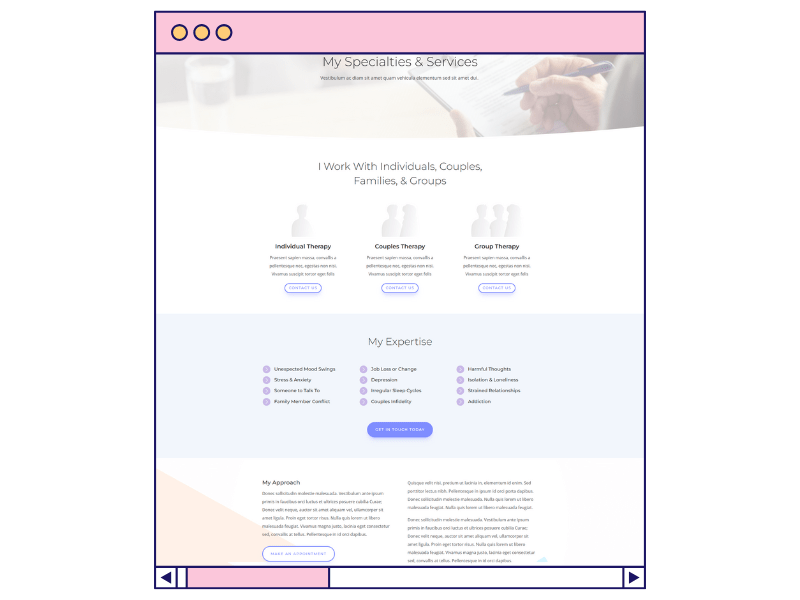
Local SEO for Therapy: The Fastest Way to Get Found in Your City
While general SEO helps your site rank nationally, local SEO ensures you show up when someone searches for therapy in your city. This is crucial for private practices, since clients almost always search for local providers rather than therapists in other states.
The most powerful tool in local SEO is your [Google Business Profile].
When a client searches for therapy in your area, Google often displays a local “3-pack”—a set of three business listings at the top of the search results. If your profile isn’t optimized, you won’t be there.
How to Optimize Your Google Business Profile
- Claim and verify your profile at Google.com/business.
- Ensure your Name, Address, and Phone Number (NAP) are accurate—Google looks for consistency across your website, directories, and listings.
- Encourage client reviews—Google prioritizes businesses with frequent, high-quality reviews.
When optimized correctly, a therapy practice’s Google Business Profile listings can drive more phone calls and website visits than traditional SEO alone.
Google Business Profile Optimization for Therapists is a fast way to start working on local search without having to utilize a ton of technical web expertise.
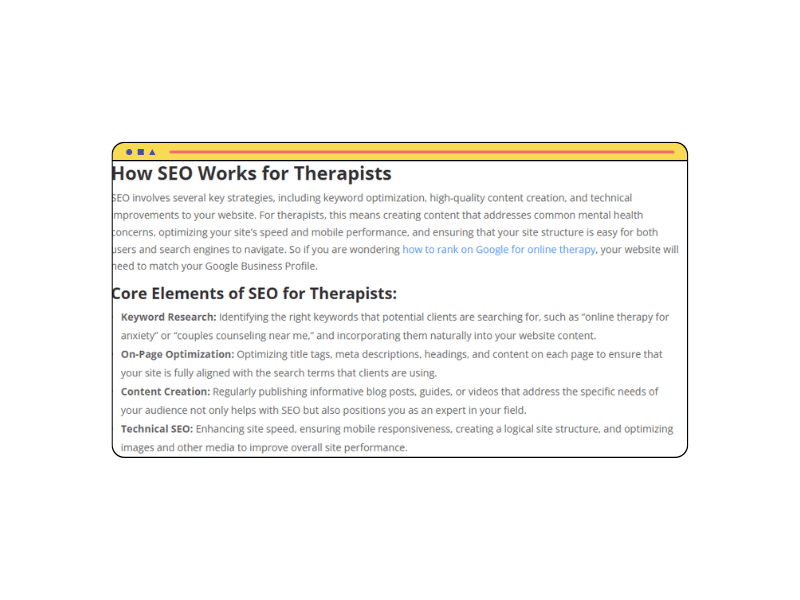
Blogging for SEO: The Key to Long-Term Visibility
You might be wondering, “Do I really need a blog?”
The short answer? Yes.
Google prioritizes fresh, relevant content. A static website with five pages won’t rank as well as one that’s regularly updated with valuable information. Blogging helps you:
- Rank for new keywords that your main website doesn’t cover.
- Show expertise in specific mental health topics, positioning you as a trusted resource.
- Increase website engagement, signaling to Google that your content is valuable.
A potential client searching “how to manage anxiety without medication” isn’t ready to book a session yet—but if they land on your blog, read helpful insights, and see you offer therapy, they’re much more likely to reach out when they are ready.
Some great blog topics for therapists include:
- “5 Signs You May Benefit from Therapy”
- “How to Handle Panic Attacks in the Moment”
- “The Difference Between Stress and Burnout (And How to Manage Both)”
Each blog post should naturally link back to your services, guiding readers toward booking an appointment.
SEO is a Long Game—But One That Pays Off
Unlike paid ads, SEO doesn’t deliver results overnight. But over time, as your rankings improve, so does your website traffic, credibility, and client inquiries.
To summarize:
- SEO helps therapists attract more clients organically.
- Local SEO ensures you rank in your area, making your practice more visible.
- Blogging boosts rankings and builds trust with potential clients.
🔹 Next Up: Now that we’ve covered SEO, let’s dive into [Google Ads for Therapists], the fastest way to get new clients without waiting for rankings to build.
Tips
Text Filler for tips, tricks, Lead Magnets and More
Text Filler for tips, tricks, Lead Magnets and More
Text Filler for tips, tricks, Lead Magnets and More
Google Ads for Therapists: How to Get More Clients Without Wasting Budget
Imagine this: A potential client wakes up in the middle of the night, overwhelmed by anxiety. They pull out their phone, open Google, and type “anxiety therapist near me.”
At that moment, they aren’t looking for a blog post. They aren’t casually scrolling social media. They need help now.
This is where Google Ads becomes one of the most powerful tools for private practice owners. Unlike SEO, which takes time to build momentum, Google Ads allows you to appear at the top of search results immediately, ensuring your practice is seen by people actively searching for therapy.
But there’s a catch: Google Ads can be expensive if not done right. Many therapists have tried running ads only to see their budget disappear with little to no results. The key is knowing how to target the right people, optimize your budget, and avoid common mistakes.
Why Google Ads Work So Well for Therapists
Google Ads (formerly Google AdWords) isn’t just about visibility—it’s about high-intent marketing. People searching for therapy services on Google are already looking for help, which makes them far more likely to book a session compared to someone casually scrolling social media. The difference between understanding Google ads vs Social media for therapy can make or break your marketing strategy.
Think about the difference:
- Someone searching “grief counselor near me” is actively looking for therapy.
- Someone seeing a Facebook ad for therapy might not be in the right mindset to book.
That’s why Google Ads consistently deliver high-quality leads—but only if you structure your campaign properly.

Setting Up a Profitable Google Ads Campaign
Many therapists waste money on Google Ads because they don’t structure their campaigns correctly. A well-optimized campaign doesn’t just get clicks—it gets inquiries and bookings.
It all starts with choosing the right keywords.
Choosing the Right Keywords
Google Ads works by bidding on keywords, meaning you pay to appear in search results when someone types in certain phrases. The key is targeting the right searches—the ones that lead to actual client inquiries instead of wasted clicks.
A therapist specializing in couples counseling might be tempted to bid on “marriage help”—but that’s too broad. A better choice? “couples therapy in [city]” or “relationship counseling near me.”
This level of precision prevents your ads from being shown to people looking for self-help articles or general advice instead of professional services.
But keywords alone won’t guarantee success—you also need compelling ad copy and a landing page that converts.
Writing Google Ads That Actually Get Clicked
Your ad copy is the first impression potential clients will have of your practice. It needs to be clear, professional, and action-driven—not vague or overly clinical.
Compare these two ads:
🚫 Bad Ad Copy:
“Licensed Therapist Specializing in Mental Health Services. Book Today.”
✅ Great Ad Copy:
“Struggling with Anxiety? Get Help from a Trusted Therapist in [City]. Call Today for a Free Consultation.”
The difference? One speaks directly to the client’s pain points, while the other is generic and forgettable.
Your ad should:
- Address the client’s concerns (“Struggling with anxiety?”).
- Provide a clear solution (“Get help from a trusted therapist”).
- Include a strong call to action (“Call today for a free consultation.”).
But even the best ad copy won’t convert if your landing page isn’t optimized.

Landing Pages: The Secret to Converting Clicks into Clients
A common mistake therapists make is sending Google Ads traffic to their homepage instead of a dedicated landing page.
Here’s why that’s a problem:
- Your homepage is too general—it’s designed for all visitors, not just people coming from ads.
- It lacks a clear next step—people might have to click around to find contact info.
- It’s not focused on conversions—ads should lead directly to a page designed to book sessions.
A high-converting landing page should include:
✅ A headline that reassures visitors they’re in the right place.
✅ A brief description of your services and who you help.
✅ A clear call-to-action (CTA) such as “Book a Free Consultation” or “Schedule an Appointment.”
✅ A simple contact form—don’t ask for too much info upfront.
The goal? Make it as easy as possible for someone to book a session.
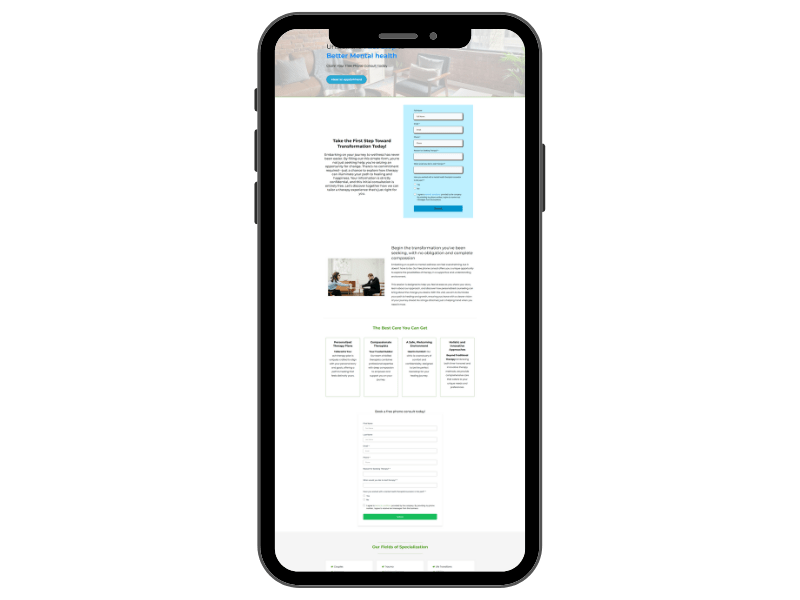
How to Avoid Wasting Money on Google Ads
Google Ads is pay-per-click (PPC)—meaning you get charged every time someone clicks your ad, whether they book a session or not. If you’re not careful, you can burn through your budget without getting results.
Here’s how to avoid wasting money on Google ads as a therapist by learning about these common mistakes:
1. Use Negative Keywords to Filter Out Bad Traffic
Not all clicks are created equal. Some searches aren’t relevant to your services, but Google will still show your ad if you don’t exclude them.
For example, if you bid on “grief counseling,” your ad might show up for searches like “free grief counseling”—even if you don’t offer free services. That’s wasted money.
Adding negative keywords like “free,” “degree,” “jobs,” or “online courses” ensures your ad only shows up for potential clients.
2. Set a Daily Budget to Control Spending
A good starting point for most therapy practices is $15–$20 per day. Once you start seeing conversions, you can scale up gradually.
3. Track Conversions (Not Just Clicks)
Many therapists make the mistake of measuring clicks instead of conversions. If your ad gets 100 clicks but only 1 appointment booking, something is off—either the ad copy, landing page, or targeting needs adjustment.
With Google Analytics and conversion tracking, you can see which keywords and ads lead to actual inquiries, allowing you to optimize your campaign for better ROI.
Google Ads: The Fastest Way to Get Clients, When Done Right
If you’re looking for a way to fill your practice quickly, Google Ads is one of the most effective digital marketing tools available. When structured correctly, it delivers high-intent leads ready to book a session.
But it’s not a set-it-and-forget-it strategy. To get the most out of your investment, you need to:
- Choose the right keywords that attract real clients.
- Write clear, compelling ads that speak to their needs.
- Send traffic to a dedicated landing page designed for conversions.
- Track performance and adjust based on what’s working.
🔹 Next Up: Now that we’ve covered Google Ads, let’s dive into [Websites for Therapists], your most important marketing asset.
Tips
Text Filler for tips, tricks, Lead Magnets and More
Text Filler for tips, tricks, Lead Magnets and More
Text Filler for tips, tricks, Lead Magnets and More
Websites for Therapists: Your Most Important Marketing Asset
Imagine a potential client hears about you through a referral. They’re interested, but they want to learn more before booking a session. What’s the first thing they do?
They Google your name.
What they find next determines whether they reach out or keep searching. If your website is outdated, slow, or difficult to navigate, you might lose them before they even read about your services.
Which is why it is important that every therapist website has a few specific sections. Like a services page, about page, detailed home page, and easy to navigate contact page.
A therapist’s website is more than just an online business card—it’s the foundation of your entire digital marketing strategy. It’s where SEO happens, where your Google Ads lead, and where potential clients decide whether to book an appointment.
If you invest in nothing else, invest in a high-quality website.
Why Your Website is the Foundation of Your Digital Strategy
Your website isn’t just about looking professional—it’s about converting visitors into clients. Every person who lands on your site is a potential lead. But if your website doesn’t engage them, reassure them, and make booking easy, they’ll bounce and move on to someone else.
Think of your website as your online office. When someone walks into a well-lit, welcoming space, they feel comfortable. If they step into a messy, confusing environment, they leave. The same applies to your website.
A good therapist website should immediately answer three questions for a visitor:
- Am I in the right place? (Does this therapist specialize in my issue?)
- Do I trust this person? (Does this site feel credible and professional?)
- What do I do next? (Is it easy to book a session?)
If your website doesn’t answer these questions within seconds, your visitor will leave.
Structuring Your Website for Maximum Client Conversions
Your website needs to be more than just “about me” and “contact” pages”—it should guide visitors through a journey that leads to one clear action: booking a session.
Homepage: Making a Strong First Impression
Your homepage is your digital front door. Visitors should instantly understand:
- Who you are (Licensed therapist specializing in trauma, couples therapy, etc.)
- Who you help (Adults, teens, couples, etc.)
- How to take the next step (Schedule a consultation, call now, fill out a form, etc.)
A simple, welcoming headline like:
“Helping [your target audience] Overcome [specific problem] So They Can [desired outcome].”
…is far more effective than something generic like “Providing Mental Health Services.”
Service Pages: Clearly Defining What You Offer
Each of your services should have its own dedicated page. Why? Because Google ranks individual pages, not just whole websites.
For example, if you specialize in anxiety therapy, having a dedicated “Anxiety Therapy in [City]” page will help you rank better than a general “Services” page listing everything together.
Your service pages should:
- Explain who the service is for and the problems it helps with.
- Reassure potential clients how therapy can help.
- Offer a clear call-to-action (CTA)—what they should do next.
A simple “Learn More” button isn’t enough. Make it actionable:
🚀 “Schedule a Free 15-Minute Consultation”
📅 “Book Your First Session Today”

About Page: Building Trust with Potential Clients
Your About page isn’t just about your credentials—it’s about helping potential clients connect with you.
Instead of leading with degrees and certifications, start with why you became a therapist. Let your personality come through. People don’t just choose therapists based on expertise—they choose someone they feel they can trust.
Example opening:
“I know how overwhelming it feels when anxiety takes over your daily life. I’ve dedicated my career to helping people regain control and feel more at peace.”
Then, you can list your qualifications. Lead with connection, follow with credibility.
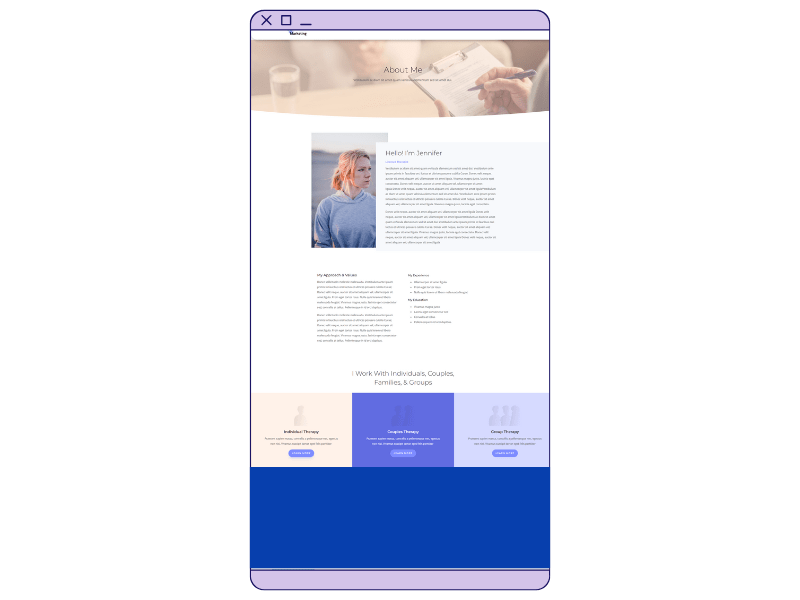
Website SEO: How to Ensure Your Site Ranks on Google
Even the best-designed website is useless if no one can find it. This is where website SEO comes in.
1. Optimize Your Pages for Local Search
Each major page (homepage, service pages, about) should include your city and service keywords naturally in the content.
For example:
🚫 “I help clients manage stress and anxiety.”
✅ “I provide anxiety therapy in Denver to help clients manage stress and regain control of their lives.”
Google needs location signals to show your site to local clients.
2. Improve Site Speed & Mobile Experience
Google ranks fast, mobile-friendly sites higher than slow, outdated ones.
- Use compressed images so they don’t slow your site down.
- Make sure your site adjusts properly on mobile devices—over 60% of therapy searches happen on phones.
Not sure if your site is mobile-friendly? Test it with Google’s Mobile-Friendly Test tool.
Should You DIY or Hire a Website Expert?
If you’re thinking about DIYing your therapy website, consider this: how much is a slow or ineffective website costing you in lost clients?
Yes, website builders like Squarespace, Wix, and WordPress make it easy to launch a site. But a template alone won’t optimize your site for SEO, conversions, or performance.
When DIY Might Work:
- You’re tech-savvy and willing to spend 20+ hours learning SEO and design.
- You’re comfortable managing site speed, updates, and mobile optimization.
When Hiring a Web Expert is the Better Choice:
- You want a website that ranks well and converts visitors from day one.
- You don’t have time to fix technical issues or optimize SEO.
If your website isn’t converting, the money you lose in potential clients far outweighs what you save by building it yourself.
Your Website: The Core of Your Marketing Strategy
At the end of the day, your website is the most important marketing tool you own. It’s where clients form their first impression, where they decide to book, and where all your other marketing efforts—SEO, Google Ads, and email campaigns—lead back to.
To recap:
- A strong website makes it easy for clients to trust you and book a session.
- Your site should be optimized for conversions, SEO, and mobile-friendliness.
- A poor website can cost you clients—make sure yours is working for you, not against you.
About Page: Building Trust with Potential Clients
Your About page isn’t just about your credentials—it’s about helping potential clients connect with you.
Instead of leading with degrees and certifications, start with why you became a therapist. Let your personality come through. People don’t just choose therapists based on expertise—they choose someone they feel they can trust.
Example opening:
“I know how overwhelming it feels when anxiety takes over your daily life. I’ve dedicated my career to helping people regain control and feel more at peace.”
Then, you can list your qualifications. Lead with connection, follow with credibility.
Tips
Text Filler for tips, tricks, Lead Magnets and More
Text Filler for tips, tricks, Lead Magnets and More
Text Filler for tips, tricks, Lead Magnets and More
Analytics & Conversion Tracking: How to Know What’s Actually Working
You’ve optimized your website, invested in SEO, maybe even launched a few Google Ads—but how do you know what’s bringing people in?
That’s where analytics and conversion tracking come in.
They show you what’s working behind the scenes: which pages are getting traffic, which ads are turning into inquiries, and where clients are dropping off before they ever reach out. Without data, you’re guessing. With it, you’re growing—with purpose.
Let’s walk through how to make sure your digital marketing efforts are measurable, trackable, and leading to real results.
Why Therapists Need to Track Their Marketing Efforts
Most therapists don’t get excited about analytics—and that’s okay. But if you’re spending time or money on marketing, you deserve to know what you’re getting back.
With just a few tools in place, you can answer big questions like:
- How are people finding your website?
- Are your ads actually converting?
- Which service pages get the most engagement?
And you don’t have to become a data analyst to figure it out. The right setup can give you the insights you need without the overwhelm.
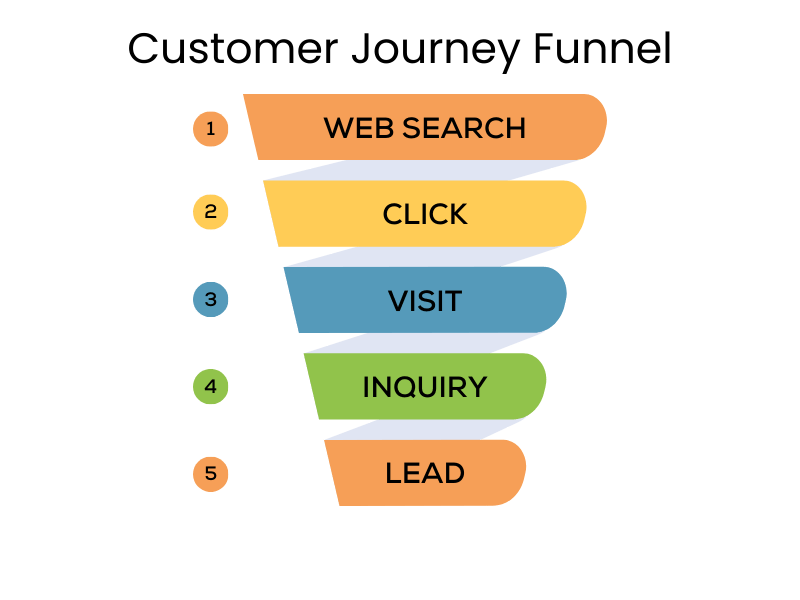
How to Use Google Analytics to Understand Traffic
The first tool every private practice should have installed is Google Analytics—specifically, Google Analytics 4 (GA4).
GA4 tracks:
- How many people are visiting your site
- Where your visitors are coming from (Google search, ads, referrals, etc.)
- What pages they visit, how long they stay, and when they leave
Example: If your “Anxiety Therapy in Denver” page is getting lots of traffic but no inquiries, you know to improve the layout or call to action. If your homepage is getting traffic mostly from ads, that tells you your Google Ads campaign is working.
Not sure if GA4 is set up on your site? Ask your web designer or marketing partner—they can install it in minutes.
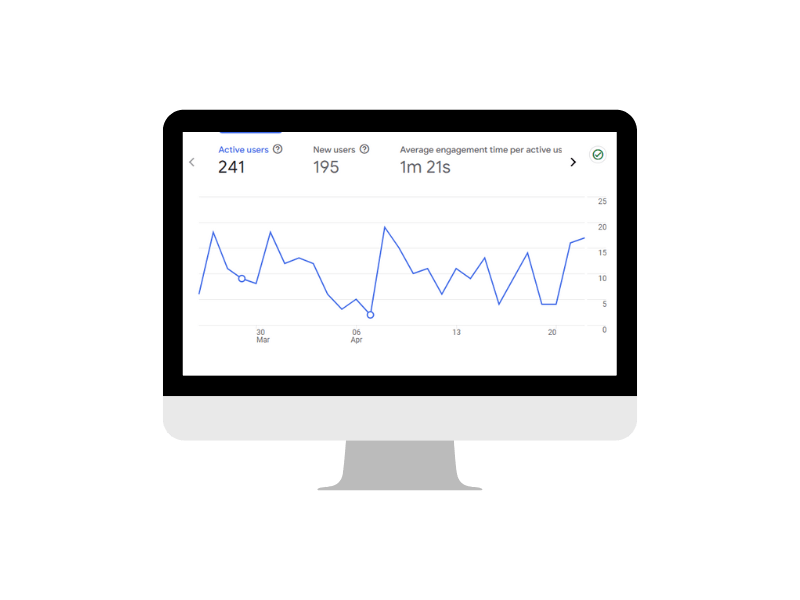
Conversion Tracking: What’s Bringing in Actual Clients
Traffic is great—but what really matters is conversions: the actions that show someone is ready to work with you.
You’ll want to track things like:
- Contact form submissions
- Phone number clicks (especially from mobile)
- Appointment bookings
If you’re running Google Ads, this is non-negotiable. Without conversion tracking, you’ll never know which ads are worth the money—and which ones are draining your budget.
Tools like Google Tag Manager make it easier to set this up without editing your website constantly.
Focus on the Metrics That Matter Most
You don’t need to track everything—just the metrics that show whether your marketing is moving the needle.
📊 Traffic by Source – Where are people finding you?
📈 Conversion Rate – How many website visitors become inquiries?
💰 Cost Per Conversion – For ads: how much does it cost to get someone to reach out?
By monitoring these, you can spend less time guessing and more time doubling down on what works.
Analytics: Your Secret Weapon for Smarter Marketing
You don’t need to love numbers—but you do need to know what’s bringing in clients. Analytics and conversion tracking turn your website, ads, and SEO from a shot in the dark into a strategy that delivers real results.
Once you know what’s working, you can confidently invest in growing your practice—and stop wasting time on guesswork.
🔹 Next Up: Now that we’ve covered how to track your marketing performance, let’s wrap up with a final look at how to put all these strategies together for a powerful, integrated digital marketing plan.
Tips
Text Filler for tips, tricks, Lead Magnets and More
Text Filler for tips, tricks, Lead Magnets and More
Text Filler for tips, tricks, Lead Magnets and More
Final Thoughts: Why Marketing Your Practice Matters
Therapists often hesitate to invest in marketing, worrying it feels salesy or inauthentic. But marketing isn’t about selling—it’s about helping people find the support they need.
Your ideal clients are already searching for you. The question is: Will they find you—or someone else?
By implementing the strategies in this guide, you’re not just growing your practice—you’re making it easier for people to get the help they need. That’s what makes ethical marketing for therapists so powerful.
Need Help Putting This Into Action? Let’s Talk.
If you’re ready to attract more clients, optimize your marketing, and grow your practice without stress, we can help.
✔ Want a website that actually converts? We build high-converting, therapist-friendly sites.
✔ Need help running profitable Google Ads? We handle the strategy, so you get real results without wasted spend.
✔ Want an SEO strategy that gets you ranked? We optimize your site so clients find you—organically.
🚀 Let’s create a digital marketing strategy that works for you.
Ready to take your therapy practice to the next level? At Cognitive Pulse Marketing, we specialize in helping therapists grow their practices with tailored marketing strategies, from website optimization to SEO and beyond. Contact us today for a free consultation and see how we can help you attract more clients and build a thriving practice.
